Business and Business Environment Analysis: Tesco's Operations Report
VerifiedAdded on 2023/01/06
|14
|4276
|23
Report
AI Summary
This report provides a comprehensive analysis of Tesco's business environment, covering various organizational types (private, public, and voluntary) and their purposes. It delves into the size and scope of different organizational structures, using Tesco, Brilliant Club, and Amnesty International as examples. The report examines the interrelationships between different functional units within Tesco, such as marketing, HR, and finance, and how these functions are linked to the company's objectives and organizational structure. It also identifies the impacts of the macro environment on Tesco's operations, utilizing PESTLE analysis to assess political, economic, social, technological, legal, and environmental factors. Furthermore, the report analyzes Tesco's internal and external factors, identifying its strengths and weaknesses and their interrelations with the macro-environmental factors. The report concludes with recommendations for Tesco to manage the macro and micro factors affecting the organization.
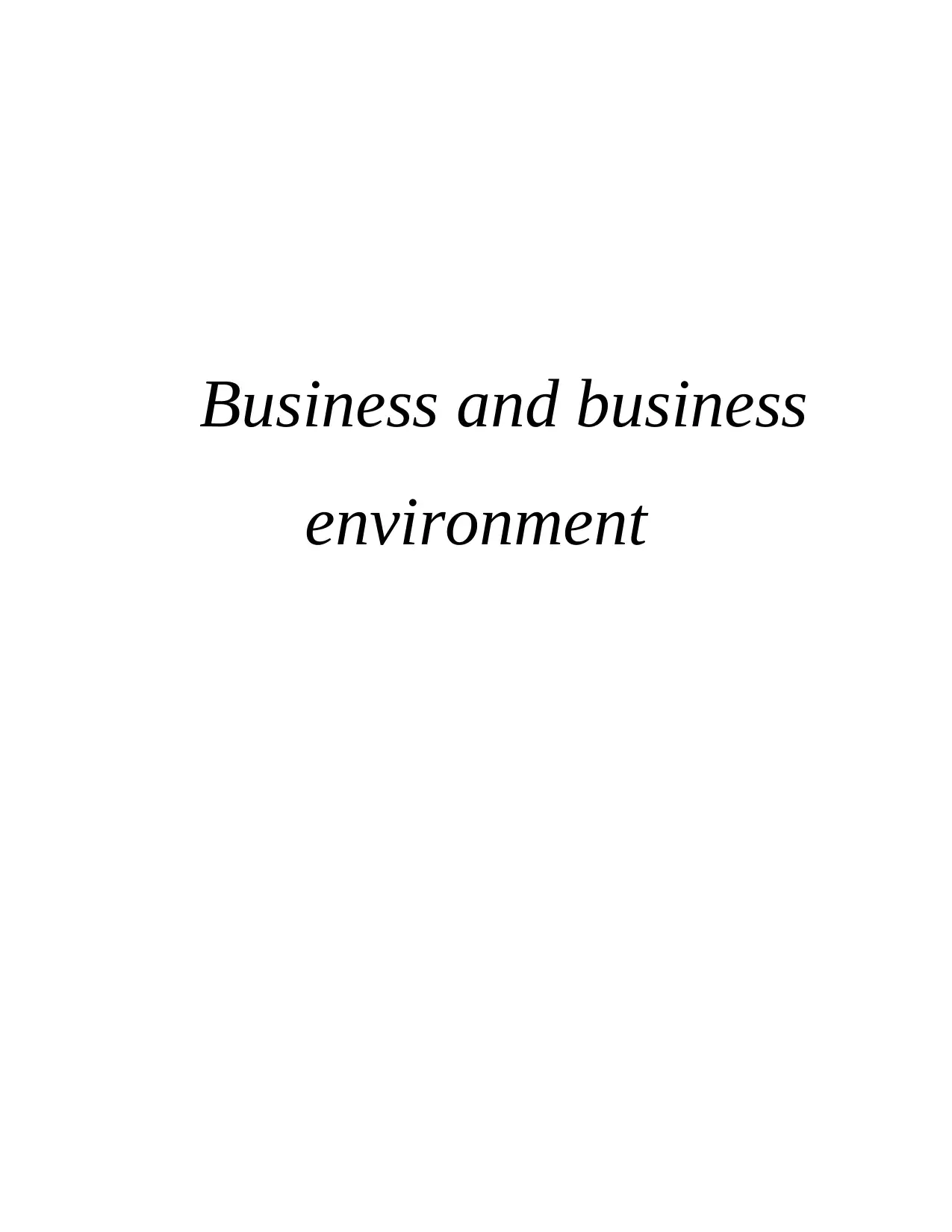
Business and business
environment
environment
Paraphrase This Document
Need a fresh take? Get an instant paraphrase of this document with our AI Paraphraser
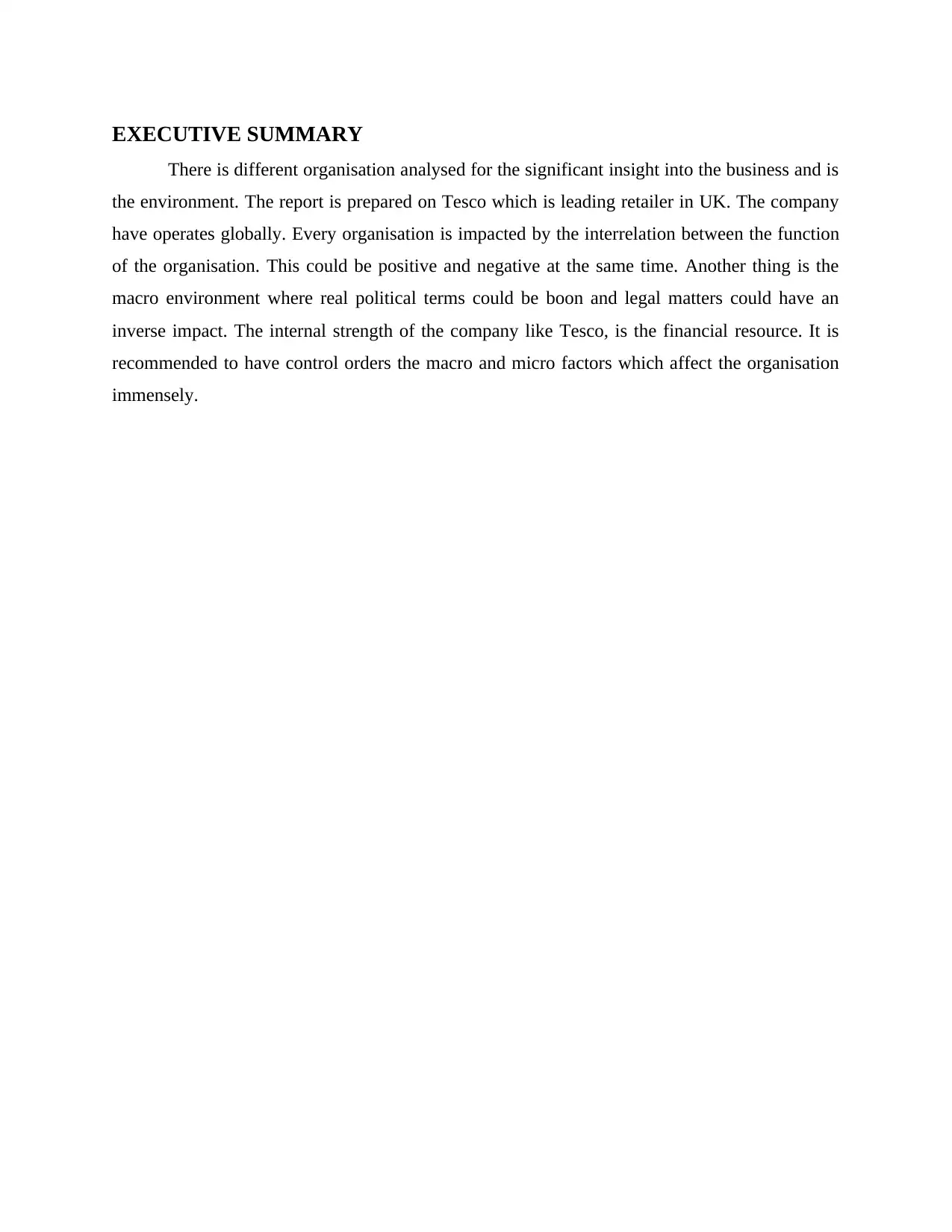
EXECUTIVE SUMMARY
There is different organisation analysed for the significant insight into the business and is
the environment. The report is prepared on Tesco which is leading retailer in UK. The company
have operates globally. Every organisation is impacted by the interrelation between the function
of the organisation. This could be positive and negative at the same time. Another thing is the
macro environment where real political terms could be boon and legal matters could have an
inverse impact. The internal strength of the company like Tesco, is the financial resource. It is
recommended to have control orders the macro and micro factors which affect the organisation
immensely.
There is different organisation analysed for the significant insight into the business and is
the environment. The report is prepared on Tesco which is leading retailer in UK. The company
have operates globally. Every organisation is impacted by the interrelation between the function
of the organisation. This could be positive and negative at the same time. Another thing is the
macro environment where real political terms could be boon and legal matters could have an
inverse impact. The internal strength of the company like Tesco, is the financial resource. It is
recommended to have control orders the macro and micro factors which affect the organisation
immensely.
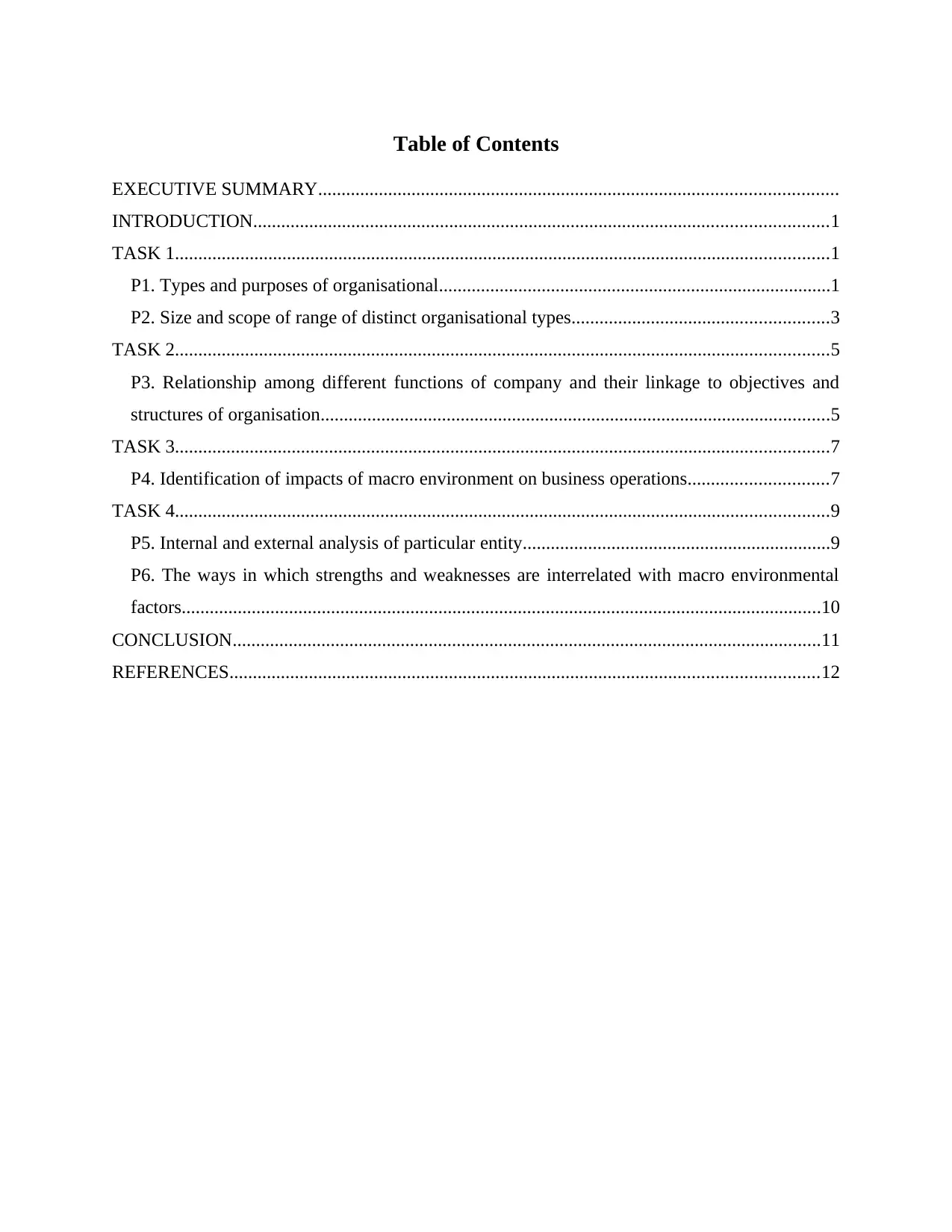
Table of Contents
EXECUTIVE SUMMARY...............................................................................................................
INTRODUCTION...........................................................................................................................1
TASK 1............................................................................................................................................1
P1. Types and purposes of organisational....................................................................................1
P2. Size and scope of range of distinct organisational types.......................................................3
TASK 2............................................................................................................................................5
P3. Relationship among different functions of company and their linkage to objectives and
structures of organisation.............................................................................................................5
TASK 3............................................................................................................................................7
P4. Identification of impacts of macro environment on business operations..............................7
TASK 4............................................................................................................................................9
P5. Internal and external analysis of particular entity..................................................................9
P6. The ways in which strengths and weaknesses are interrelated with macro environmental
factors.........................................................................................................................................10
CONCLUSION..............................................................................................................................11
REFERENCES..............................................................................................................................12
EXECUTIVE SUMMARY...............................................................................................................
INTRODUCTION...........................................................................................................................1
TASK 1............................................................................................................................................1
P1. Types and purposes of organisational....................................................................................1
P2. Size and scope of range of distinct organisational types.......................................................3
TASK 2............................................................................................................................................5
P3. Relationship among different functions of company and their linkage to objectives and
structures of organisation.............................................................................................................5
TASK 3............................................................................................................................................7
P4. Identification of impacts of macro environment on business operations..............................7
TASK 4............................................................................................................................................9
P5. Internal and external analysis of particular entity..................................................................9
P6. The ways in which strengths and weaknesses are interrelated with macro environmental
factors.........................................................................................................................................10
CONCLUSION..............................................................................................................................11
REFERENCES..............................................................................................................................12
⊘ This is a preview!⊘
Do you want full access?
Subscribe today to unlock all pages.

Trusted by 1+ million students worldwide
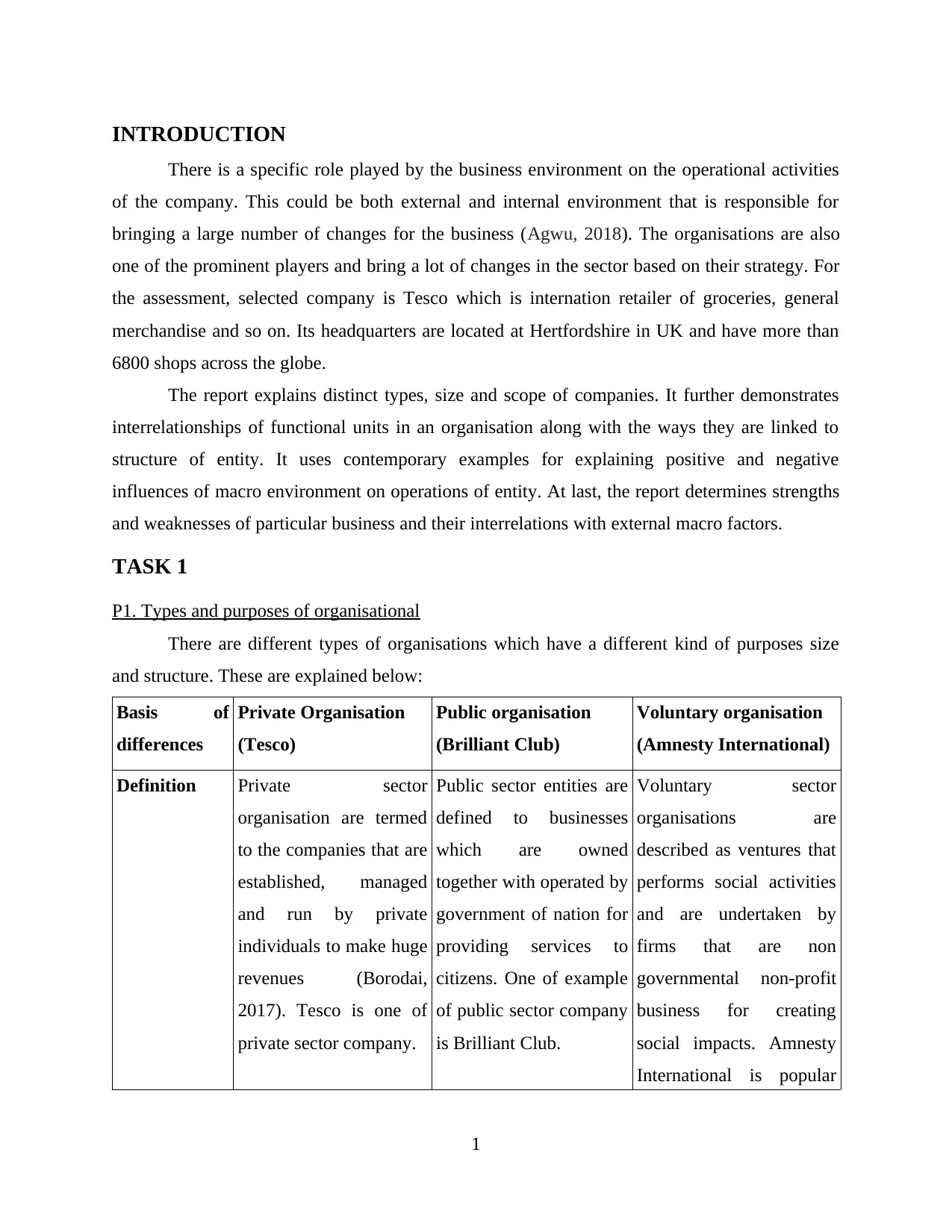
INTRODUCTION
There is a specific role played by the business environment on the operational activities
of the company. This could be both external and internal environment that is responsible for
bringing a large number of changes for the business (Agwu, 2018). The organisations are also
one of the prominent players and bring a lot of changes in the sector based on their strategy. For
the assessment, selected company is Tesco which is internation retailer of groceries, general
merchandise and so on. Its headquarters are located at Hertfordshire in UK and have more than
6800 shops across the globe.
The report explains distinct types, size and scope of companies. It further demonstrates
interrelationships of functional units in an organisation along with the ways they are linked to
structure of entity. It uses contemporary examples for explaining positive and negative
influences of macro environment on operations of entity. At last, the report determines strengths
and weaknesses of particular business and their interrelations with external macro factors.
TASK 1
P1. Types and purposes of organisational
There are different types of organisations which have a different kind of purposes size
and structure. These are explained below:
Basis of
differences
Private Organisation
(Tesco)
Public organisation
(Brilliant Club)
Voluntary organisation
(Amnesty International)
Definition Private sector
organisation are termed
to the companies that are
established, managed
and run by private
individuals to make huge
revenues (Borodai,
2017). Tesco is one of
private sector company.
Public sector entities are
defined to businesses
which are owned
together with operated by
government of nation for
providing services to
citizens. One of example
of public sector company
is Brilliant Club.
Voluntary sector
organisations are
described as ventures that
performs social activities
and are undertaken by
firms that are non
governmental non-profit
business for creating
social impacts. Amnesty
International is popular
1
There is a specific role played by the business environment on the operational activities
of the company. This could be both external and internal environment that is responsible for
bringing a large number of changes for the business (Agwu, 2018). The organisations are also
one of the prominent players and bring a lot of changes in the sector based on their strategy. For
the assessment, selected company is Tesco which is internation retailer of groceries, general
merchandise and so on. Its headquarters are located at Hertfordshire in UK and have more than
6800 shops across the globe.
The report explains distinct types, size and scope of companies. It further demonstrates
interrelationships of functional units in an organisation along with the ways they are linked to
structure of entity. It uses contemporary examples for explaining positive and negative
influences of macro environment on operations of entity. At last, the report determines strengths
and weaknesses of particular business and their interrelations with external macro factors.
TASK 1
P1. Types and purposes of organisational
There are different types of organisations which have a different kind of purposes size
and structure. These are explained below:
Basis of
differences
Private Organisation
(Tesco)
Public organisation
(Brilliant Club)
Voluntary organisation
(Amnesty International)
Definition Private sector
organisation are termed
to the companies that are
established, managed
and run by private
individuals to make huge
revenues (Borodai,
2017). Tesco is one of
private sector company.
Public sector entities are
defined to businesses
which are owned
together with operated by
government of nation for
providing services to
citizens. One of example
of public sector company
is Brilliant Club.
Voluntary sector
organisations are
described as ventures that
performs social activities
and are undertaken by
firms that are non
governmental non-profit
business for creating
social impacts. Amnesty
International is popular
1
Paraphrase This Document
Need a fresh take? Get an instant paraphrase of this document with our AI Paraphraser

example of voluntary
sector organisation.
Purpose The main purpose for
which private
organisation work is to
make larger profits and
maximise market shares.
Public sector
organisation have
purpose of serving its
citizens by providing
services on time and
fostering community
welfare.
Main purpose of
voluntary sector
organisation is to resolve
particular causes as well
as make improvements for
citizen's welfare (Drucker,
2017).
Legal
structure
Legal structures of
private organisation are:
Partnership Limited in
which contractual
arrangement are formed
among two or more
businesses for
management (Hamilton
and Webster, 2018).
Sole trader wherein an
individual establishes
and manage the
company without any
type of legal identity.
Private limited
company is another
structure in which
shareholders are
restricted for trading as
well as liabilities of
shares are restricted to
In public sector
organisations, some of
legal structure are below:
Central government is
the legal structure that
holds controlling powers
for unitary states.
State government is
other structure wherein
national government
have powers and
authorities.
Local government is
structure in which
municipal government
looks after towns, cities
and districts.
In context to Brilliant
Club, legal structure of
state government is
followed in it.
Legal structures that are
followed in voluntary
sector organisations are
defined below:
Trust structure in which
few people are said to
trustees as they provide
financial support to the
entity.
Unincorporated
structure that is
independent of single
person that makes
working easy to enter into
various contracts.
In Amnesty International,
trust legal structure is
favoured more than other
structures.
2
sector organisation.
Purpose The main purpose for
which private
organisation work is to
make larger profits and
maximise market shares.
Public sector
organisation have
purpose of serving its
citizens by providing
services on time and
fostering community
welfare.
Main purpose of
voluntary sector
organisation is to resolve
particular causes as well
as make improvements for
citizen's welfare (Drucker,
2017).
Legal
structure
Legal structures of
private organisation are:
Partnership Limited in
which contractual
arrangement are formed
among two or more
businesses for
management (Hamilton
and Webster, 2018).
Sole trader wherein an
individual establishes
and manage the
company without any
type of legal identity.
Private limited
company is another
structure in which
shareholders are
restricted for trading as
well as liabilities of
shares are restricted to
In public sector
organisations, some of
legal structure are below:
Central government is
the legal structure that
holds controlling powers
for unitary states.
State government is
other structure wherein
national government
have powers and
authorities.
Local government is
structure in which
municipal government
looks after towns, cities
and districts.
In context to Brilliant
Club, legal structure of
state government is
followed in it.
Legal structures that are
followed in voluntary
sector organisations are
defined below:
Trust structure in which
few people are said to
trustees as they provide
financial support to the
entity.
Unincorporated
structure that is
independent of single
person that makes
working easy to enter into
various contracts.
In Amnesty International,
trust legal structure is
favoured more than other
structures.
2
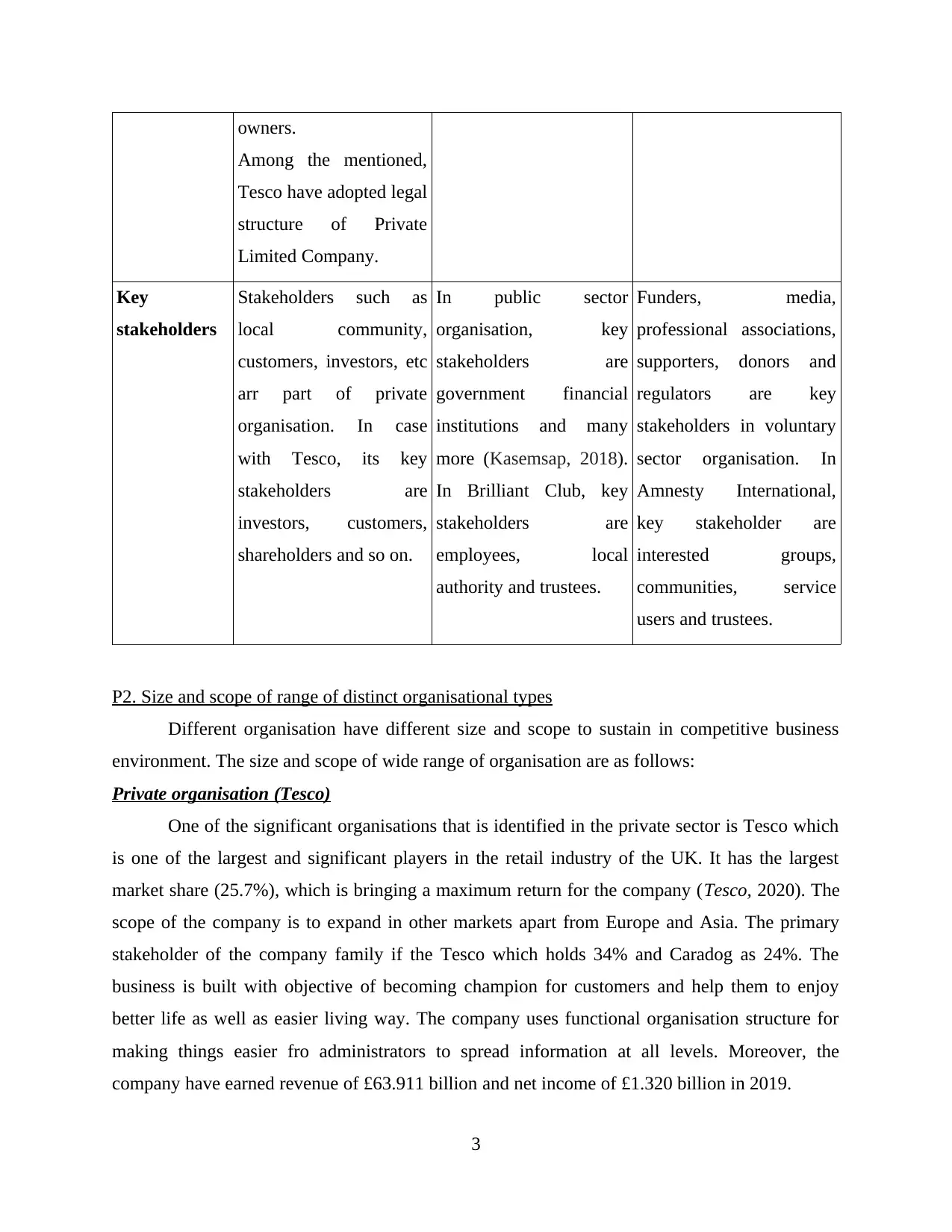
owners.
Among the mentioned,
Tesco have adopted legal
structure of Private
Limited Company.
Key
stakeholders
Stakeholders such as
local community,
customers, investors, etc
arr part of private
organisation. In case
with Tesco, its key
stakeholders are
investors, customers,
shareholders and so on.
In public sector
organisation, key
stakeholders are
government financial
institutions and many
more (Kasemsap, 2018).
In Brilliant Club, key
stakeholders are
employees, local
authority and trustees.
Funders, media,
professional associations,
supporters, donors and
regulators are key
stakeholders in voluntary
sector organisation. In
Amnesty International,
key stakeholder are
interested groups,
communities, service
users and trustees.
P2. Size and scope of range of distinct organisational types
Different organisation have different size and scope to sustain in competitive business
environment. The size and scope of wide range of organisation are as follows:
Private organisation (Tesco)
One of the significant organisations that is identified in the private sector is Tesco which
is one of the largest and significant players in the retail industry of the UK. It has the largest
market share (25.7%), which is bringing a maximum return for the company (Tesco, 2020). The
scope of the company is to expand in other markets apart from Europe and Asia. The primary
stakeholder of the company family if the Tesco which holds 34% and Caradog as 24%. The
business is built with objective of becoming champion for customers and help them to enjoy
better life as well as easier living way. The company uses functional organisation structure for
making things easier fro administrators to spread information at all levels. Moreover, the
company have earned revenue of £63.911 billion and net income of £1.320 billion in 2019.
3
Among the mentioned,
Tesco have adopted legal
structure of Private
Limited Company.
Key
stakeholders
Stakeholders such as
local community,
customers, investors, etc
arr part of private
organisation. In case
with Tesco, its key
stakeholders are
investors, customers,
shareholders and so on.
In public sector
organisation, key
stakeholders are
government financial
institutions and many
more (Kasemsap, 2018).
In Brilliant Club, key
stakeholders are
employees, local
authority and trustees.
Funders, media,
professional associations,
supporters, donors and
regulators are key
stakeholders in voluntary
sector organisation. In
Amnesty International,
key stakeholder are
interested groups,
communities, service
users and trustees.
P2. Size and scope of range of distinct organisational types
Different organisation have different size and scope to sustain in competitive business
environment. The size and scope of wide range of organisation are as follows:
Private organisation (Tesco)
One of the significant organisations that is identified in the private sector is Tesco which
is one of the largest and significant players in the retail industry of the UK. It has the largest
market share (25.7%), which is bringing a maximum return for the company (Tesco, 2020). The
scope of the company is to expand in other markets apart from Europe and Asia. The primary
stakeholder of the company family if the Tesco which holds 34% and Caradog as 24%. The
business is built with objective of becoming champion for customers and help them to enjoy
better life as well as easier living way. The company uses functional organisation structure for
making things easier fro administrators to spread information at all levels. Moreover, the
company have earned revenue of £63.911 billion and net income of £1.320 billion in 2019.
3
⊘ This is a preview!⊘
Do you want full access?
Subscribe today to unlock all pages.

Trusted by 1+ million students worldwide
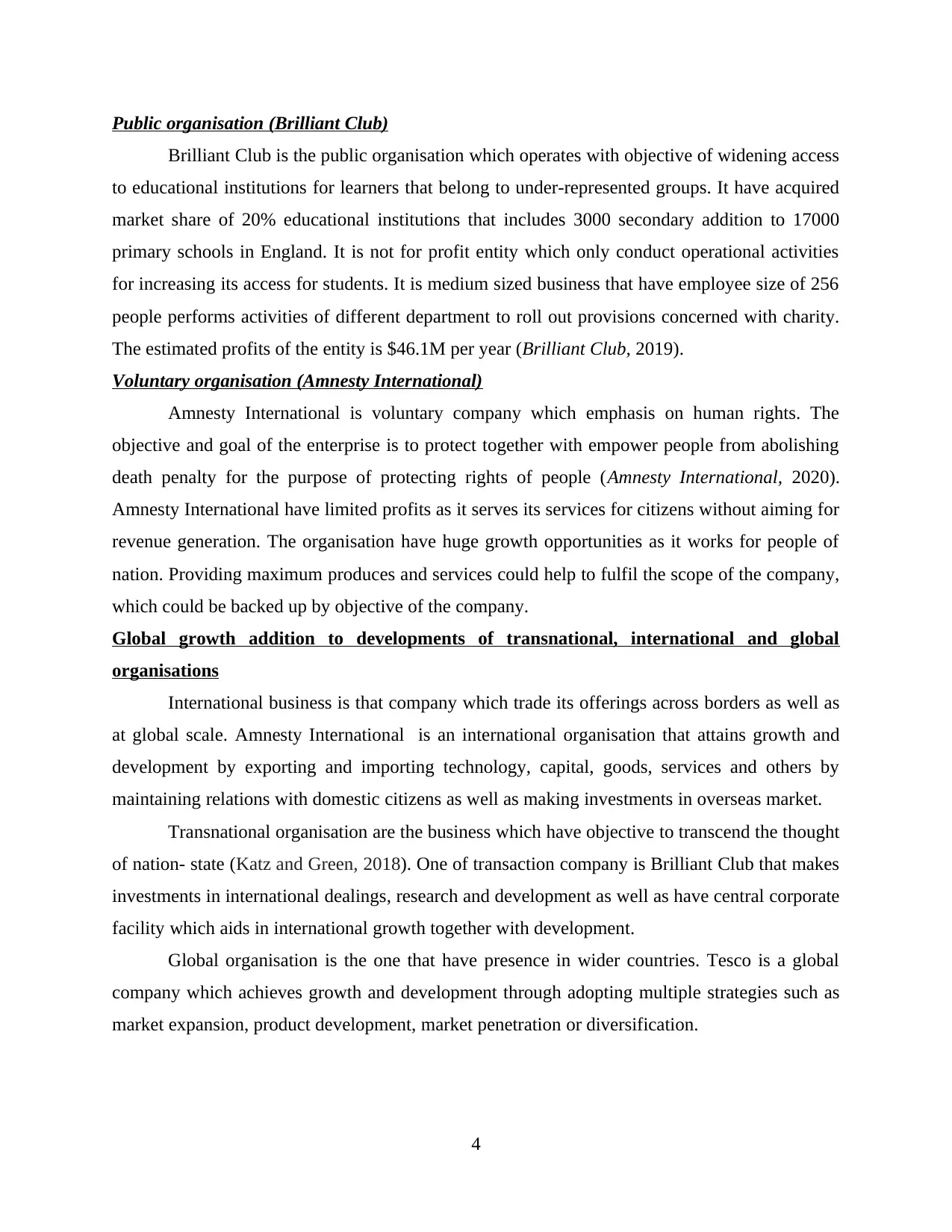
Public organisation (Brilliant Club)
Brilliant Club is the public organisation which operates with objective of widening access
to educational institutions for learners that belong to under-represented groups. It have acquired
market share of 20% educational institutions that includes 3000 secondary addition to 17000
primary schools in England. It is not for profit entity which only conduct operational activities
for increasing its access for students. It is medium sized business that have employee size of 256
people performs activities of different department to roll out provisions concerned with charity.
The estimated profits of the entity is $46.1M per year (Brilliant Club, 2019).
Voluntary organisation (Amnesty International)
Amnesty International is voluntary company which emphasis on human rights. The
objective and goal of the enterprise is to protect together with empower people from abolishing
death penalty for the purpose of protecting rights of people (Amnesty International, 2020).
Amnesty International have limited profits as it serves its services for citizens without aiming for
revenue generation. The organisation have huge growth opportunities as it works for people of
nation. Providing maximum produces and services could help to fulfil the scope of the company,
which could be backed up by objective of the company.
Global growth addition to developments of transnational, international and global
organisations
International business is that company which trade its offerings across borders as well as
at global scale. Amnesty International is an international organisation that attains growth and
development by exporting and importing technology, capital, goods, services and others by
maintaining relations with domestic citizens as well as making investments in overseas market.
Transnational organisation are the business which have objective to transcend the thought
of nation- state (Katz and Green, 2018). One of transaction company is Brilliant Club that makes
investments in international dealings, research and development as well as have central corporate
facility which aids in international growth together with development.
Global organisation is the one that have presence in wider countries. Tesco is a global
company which achieves growth and development through adopting multiple strategies such as
market expansion, product development, market penetration or diversification.
4
Brilliant Club is the public organisation which operates with objective of widening access
to educational institutions for learners that belong to under-represented groups. It have acquired
market share of 20% educational institutions that includes 3000 secondary addition to 17000
primary schools in England. It is not for profit entity which only conduct operational activities
for increasing its access for students. It is medium sized business that have employee size of 256
people performs activities of different department to roll out provisions concerned with charity.
The estimated profits of the entity is $46.1M per year (Brilliant Club, 2019).
Voluntary organisation (Amnesty International)
Amnesty International is voluntary company which emphasis on human rights. The
objective and goal of the enterprise is to protect together with empower people from abolishing
death penalty for the purpose of protecting rights of people (Amnesty International, 2020).
Amnesty International have limited profits as it serves its services for citizens without aiming for
revenue generation. The organisation have huge growth opportunities as it works for people of
nation. Providing maximum produces and services could help to fulfil the scope of the company,
which could be backed up by objective of the company.
Global growth addition to developments of transnational, international and global
organisations
International business is that company which trade its offerings across borders as well as
at global scale. Amnesty International is an international organisation that attains growth and
development by exporting and importing technology, capital, goods, services and others by
maintaining relations with domestic citizens as well as making investments in overseas market.
Transnational organisation are the business which have objective to transcend the thought
of nation- state (Katz and Green, 2018). One of transaction company is Brilliant Club that makes
investments in international dealings, research and development as well as have central corporate
facility which aids in international growth together with development.
Global organisation is the one that have presence in wider countries. Tesco is a global
company which achieves growth and development through adopting multiple strategies such as
market expansion, product development, market penetration or diversification.
4
Paraphrase This Document
Need a fresh take? Get an instant paraphrase of this document with our AI Paraphraser
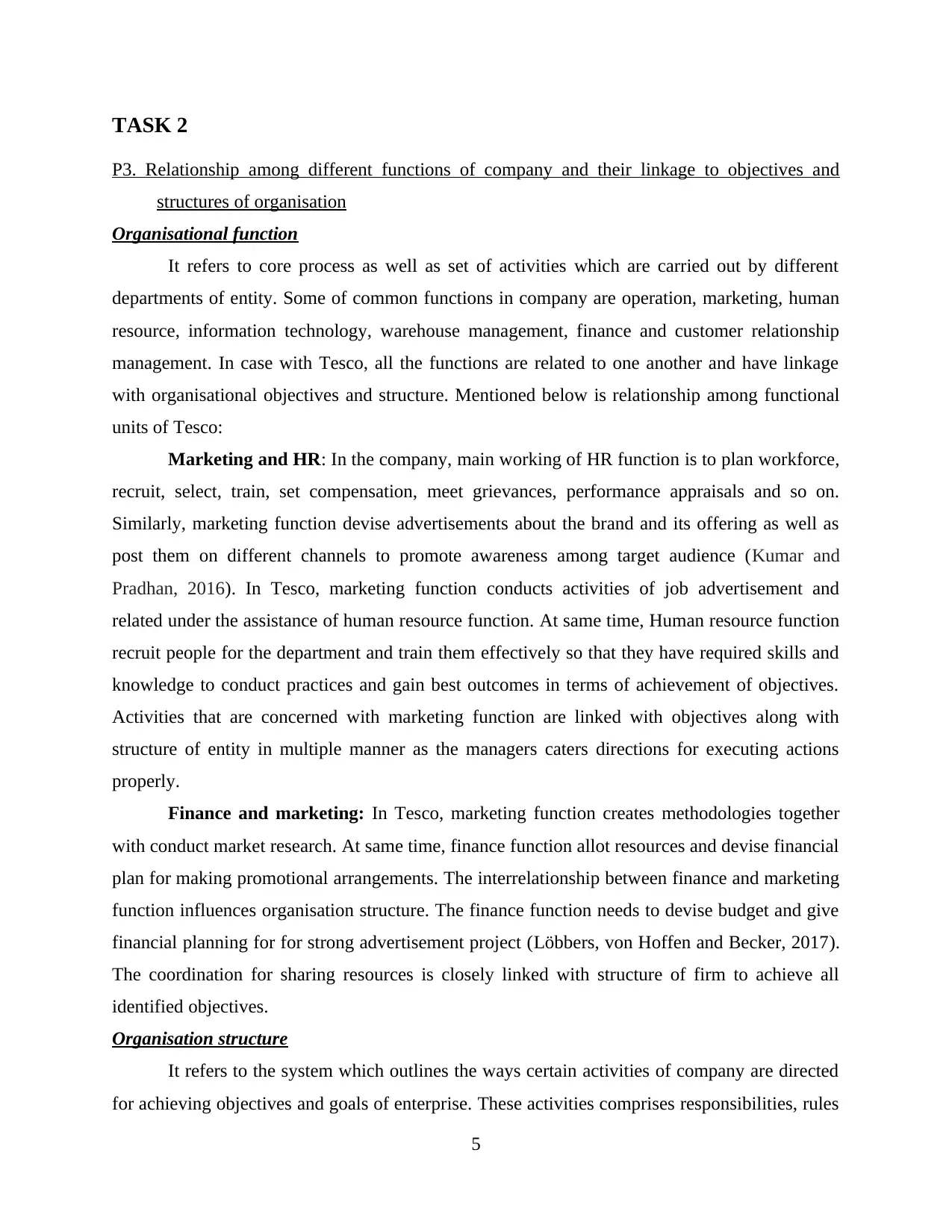
TASK 2
P3. Relationship among different functions of company and their linkage to objectives and
structures of organisation
Organisational function
It refers to core process as well as set of activities which are carried out by different
departments of entity. Some of common functions in company are operation, marketing, human
resource, information technology, warehouse management, finance and customer relationship
management. In case with Tesco, all the functions are related to one another and have linkage
with organisational objectives and structure. Mentioned below is relationship among functional
units of Tesco:
Marketing and HR: In the company, main working of HR function is to plan workforce,
recruit, select, train, set compensation, meet grievances, performance appraisals and so on.
Similarly, marketing function devise advertisements about the brand and its offering as well as
post them on different channels to promote awareness among target audience (Kumar and
Pradhan, 2016). In Tesco, marketing function conducts activities of job advertisement and
related under the assistance of human resource function. At same time, Human resource function
recruit people for the department and train them effectively so that they have required skills and
knowledge to conduct practices and gain best outcomes in terms of achievement of objectives.
Activities that are concerned with marketing function are linked with objectives along with
structure of entity in multiple manner as the managers caters directions for executing actions
properly.
Finance and marketing: In Tesco, marketing function creates methodologies together
with conduct market research. At same time, finance function allot resources and devise financial
plan for making promotional arrangements. The interrelationship between finance and marketing
function influences organisation structure. The finance function needs to devise budget and give
financial planning for for strong advertisement project (Löbbers, von Hoffen and Becker, 2017).
The coordination for sharing resources is closely linked with structure of firm to achieve all
identified objectives.
Organisation structure
It refers to the system which outlines the ways certain activities of company are directed
for achieving objectives and goals of enterprise. These activities comprises responsibilities, rules
5
P3. Relationship among different functions of company and their linkage to objectives and
structures of organisation
Organisational function
It refers to core process as well as set of activities which are carried out by different
departments of entity. Some of common functions in company are operation, marketing, human
resource, information technology, warehouse management, finance and customer relationship
management. In case with Tesco, all the functions are related to one another and have linkage
with organisational objectives and structure. Mentioned below is relationship among functional
units of Tesco:
Marketing and HR: In the company, main working of HR function is to plan workforce,
recruit, select, train, set compensation, meet grievances, performance appraisals and so on.
Similarly, marketing function devise advertisements about the brand and its offering as well as
post them on different channels to promote awareness among target audience (Kumar and
Pradhan, 2016). In Tesco, marketing function conducts activities of job advertisement and
related under the assistance of human resource function. At same time, Human resource function
recruit people for the department and train them effectively so that they have required skills and
knowledge to conduct practices and gain best outcomes in terms of achievement of objectives.
Activities that are concerned with marketing function are linked with objectives along with
structure of entity in multiple manner as the managers caters directions for executing actions
properly.
Finance and marketing: In Tesco, marketing function creates methodologies together
with conduct market research. At same time, finance function allot resources and devise financial
plan for making promotional arrangements. The interrelationship between finance and marketing
function influences organisation structure. The finance function needs to devise budget and give
financial planning for for strong advertisement project (Löbbers, von Hoffen and Becker, 2017).
The coordination for sharing resources is closely linked with structure of firm to achieve all
identified objectives.
Organisation structure
It refers to the system which outlines the ways certain activities of company are directed
for achieving objectives and goals of enterprise. These activities comprises responsibilities, rules
5

addition to roles. It determines the ways in which information flows among levels. Some of
organisational structures are as follows:
Hierarchical organisation structure: The structure puts responsibility addition to
authority on top management of firm and makes them to share or flow information down form
top to lowest level in gradual manner. In context to Tesco, it follows a hierarchical structure in
which obligations along with positions are divided into various parts for ensuring completion of
workings smoothly and efficiently (Tesco Management Hierarchy, 2018). The organisational
structure chart of Tesco is underneath:
Illustration 1: Tesco Management Hierarchy, 2018
(Source: Tesco Management Hierarchy, 2018)
Matrix organisation structure: It is workplace format wherein staff report to two or
more number of managers despite of one manager to oversee each aspect concerned with project.
The company which uses the structure enjoys benefits of communication efficiency, improves
employee motivation, maximum resource usage and enhances employee professional
development. However, its limitations are that it create potential disputes among managers and
projects as well as reduces employee effectiveness.
TASK 3
P4. Identification of impacts of macro environment on business operations
Macro environment: It refers to wider situation of economy that is opposed to particular
markets. It impacts widely on decision making and strategies of company. To monitor macro
environment, one of strategic tool used by businesses, for example, Tesco is PESTLE analysis. It
is a solid framework to determine and monitor macro environment factors which leads to have
6
organisational structures are as follows:
Hierarchical organisation structure: The structure puts responsibility addition to
authority on top management of firm and makes them to share or flow information down form
top to lowest level in gradual manner. In context to Tesco, it follows a hierarchical structure in
which obligations along with positions are divided into various parts for ensuring completion of
workings smoothly and efficiently (Tesco Management Hierarchy, 2018). The organisational
structure chart of Tesco is underneath:
Illustration 1: Tesco Management Hierarchy, 2018
(Source: Tesco Management Hierarchy, 2018)
Matrix organisation structure: It is workplace format wherein staff report to two or
more number of managers despite of one manager to oversee each aspect concerned with project.
The company which uses the structure enjoys benefits of communication efficiency, improves
employee motivation, maximum resource usage and enhances employee professional
development. However, its limitations are that it create potential disputes among managers and
projects as well as reduces employee effectiveness.
TASK 3
P4. Identification of impacts of macro environment on business operations
Macro environment: It refers to wider situation of economy that is opposed to particular
markets. It impacts widely on decision making and strategies of company. To monitor macro
environment, one of strategic tool used by businesses, for example, Tesco is PESTLE analysis. It
is a solid framework to determine and monitor macro environment factors which leads to have
6
⊘ This is a preview!⊘
Do you want full access?
Subscribe today to unlock all pages.

Trusted by 1+ million students worldwide
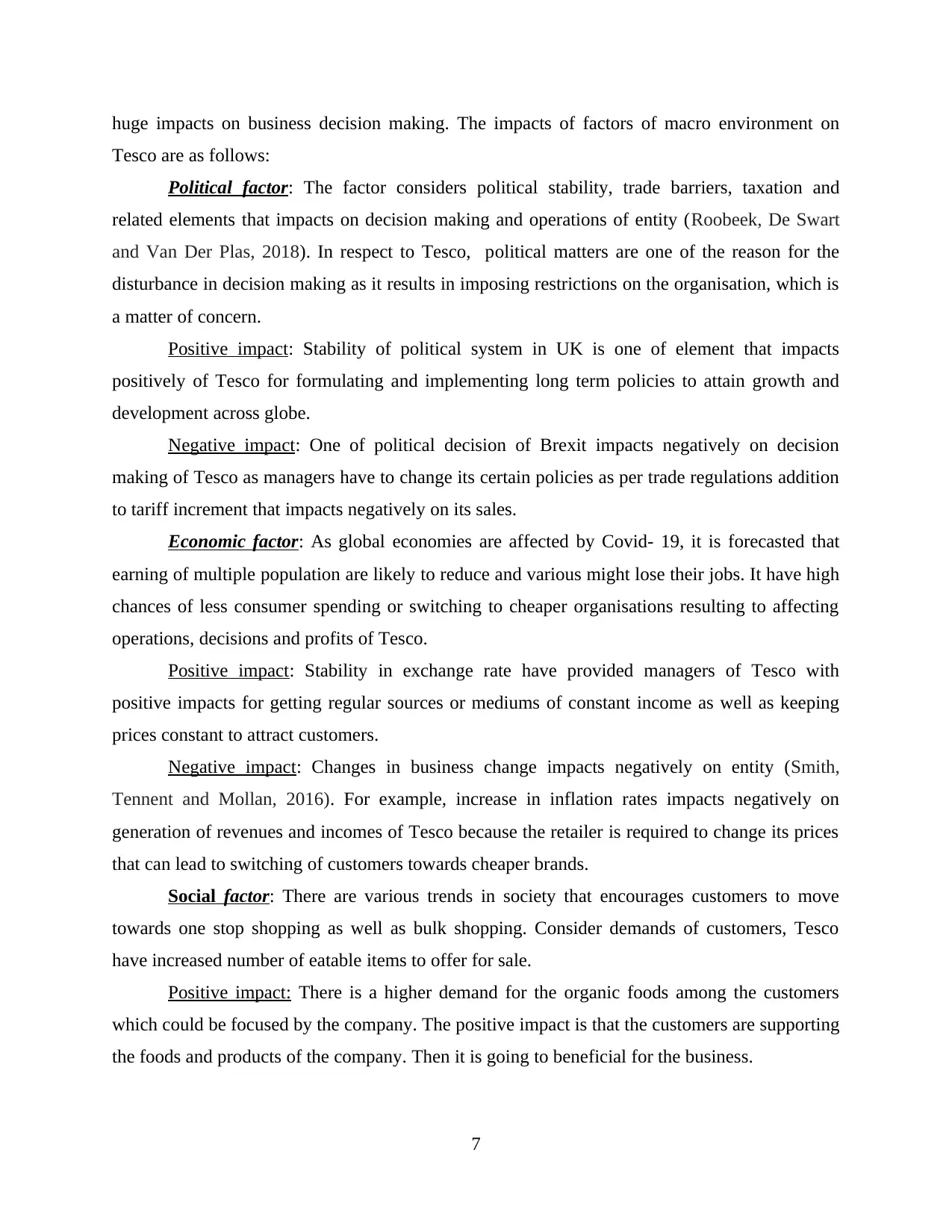
huge impacts on business decision making. The impacts of factors of macro environment on
Tesco are as follows:
Political factor: The factor considers political stability, trade barriers, taxation and
related elements that impacts on decision making and operations of entity (Roobeek, De Swart
and Van Der Plas, 2018). In respect to Tesco, political matters are one of the reason for the
disturbance in decision making as it results in imposing restrictions on the organisation, which is
a matter of concern.
Positive impact: Stability of political system in UK is one of element that impacts
positively of Tesco for formulating and implementing long term policies to attain growth and
development across globe.
Negative impact: One of political decision of Brexit impacts negatively on decision
making of Tesco as managers have to change its certain policies as per trade regulations addition
to tariff increment that impacts negatively on its sales.
Economic factor: As global economies are affected by Covid- 19, it is forecasted that
earning of multiple population are likely to reduce and various might lose their jobs. It have high
chances of less consumer spending or switching to cheaper organisations resulting to affecting
operations, decisions and profits of Tesco.
Positive impact: Stability in exchange rate have provided managers of Tesco with
positive impacts for getting regular sources or mediums of constant income as well as keeping
prices constant to attract customers.
Negative impact: Changes in business change impacts negatively on entity (Smith,
Tennent and Mollan, 2016). For example, increase in inflation rates impacts negatively on
generation of revenues and incomes of Tesco because the retailer is required to change its prices
that can lead to switching of customers towards cheaper brands.
Social factor: There are various trends in society that encourages customers to move
towards one stop shopping as well as bulk shopping. Consider demands of customers, Tesco
have increased number of eatable items to offer for sale.
Positive impact: There is a higher demand for the organic foods among the customers
which could be focused by the company. The positive impact is that the customers are supporting
the foods and products of the company. Then it is going to beneficial for the business.
7
Tesco are as follows:
Political factor: The factor considers political stability, trade barriers, taxation and
related elements that impacts on decision making and operations of entity (Roobeek, De Swart
and Van Der Plas, 2018). In respect to Tesco, political matters are one of the reason for the
disturbance in decision making as it results in imposing restrictions on the organisation, which is
a matter of concern.
Positive impact: Stability of political system in UK is one of element that impacts
positively of Tesco for formulating and implementing long term policies to attain growth and
development across globe.
Negative impact: One of political decision of Brexit impacts negatively on decision
making of Tesco as managers have to change its certain policies as per trade regulations addition
to tariff increment that impacts negatively on its sales.
Economic factor: As global economies are affected by Covid- 19, it is forecasted that
earning of multiple population are likely to reduce and various might lose their jobs. It have high
chances of less consumer spending or switching to cheaper organisations resulting to affecting
operations, decisions and profits of Tesco.
Positive impact: Stability in exchange rate have provided managers of Tesco with
positive impacts for getting regular sources or mediums of constant income as well as keeping
prices constant to attract customers.
Negative impact: Changes in business change impacts negatively on entity (Smith,
Tennent and Mollan, 2016). For example, increase in inflation rates impacts negatively on
generation of revenues and incomes of Tesco because the retailer is required to change its prices
that can lead to switching of customers towards cheaper brands.
Social factor: There are various trends in society that encourages customers to move
towards one stop shopping as well as bulk shopping. Consider demands of customers, Tesco
have increased number of eatable items to offer for sale.
Positive impact: There is a higher demand for the organic foods among the customers
which could be focused by the company. The positive impact is that the customers are supporting
the foods and products of the company. Then it is going to beneficial for the business.
7
Paraphrase This Document
Need a fresh take? Get an instant paraphrase of this document with our AI Paraphraser
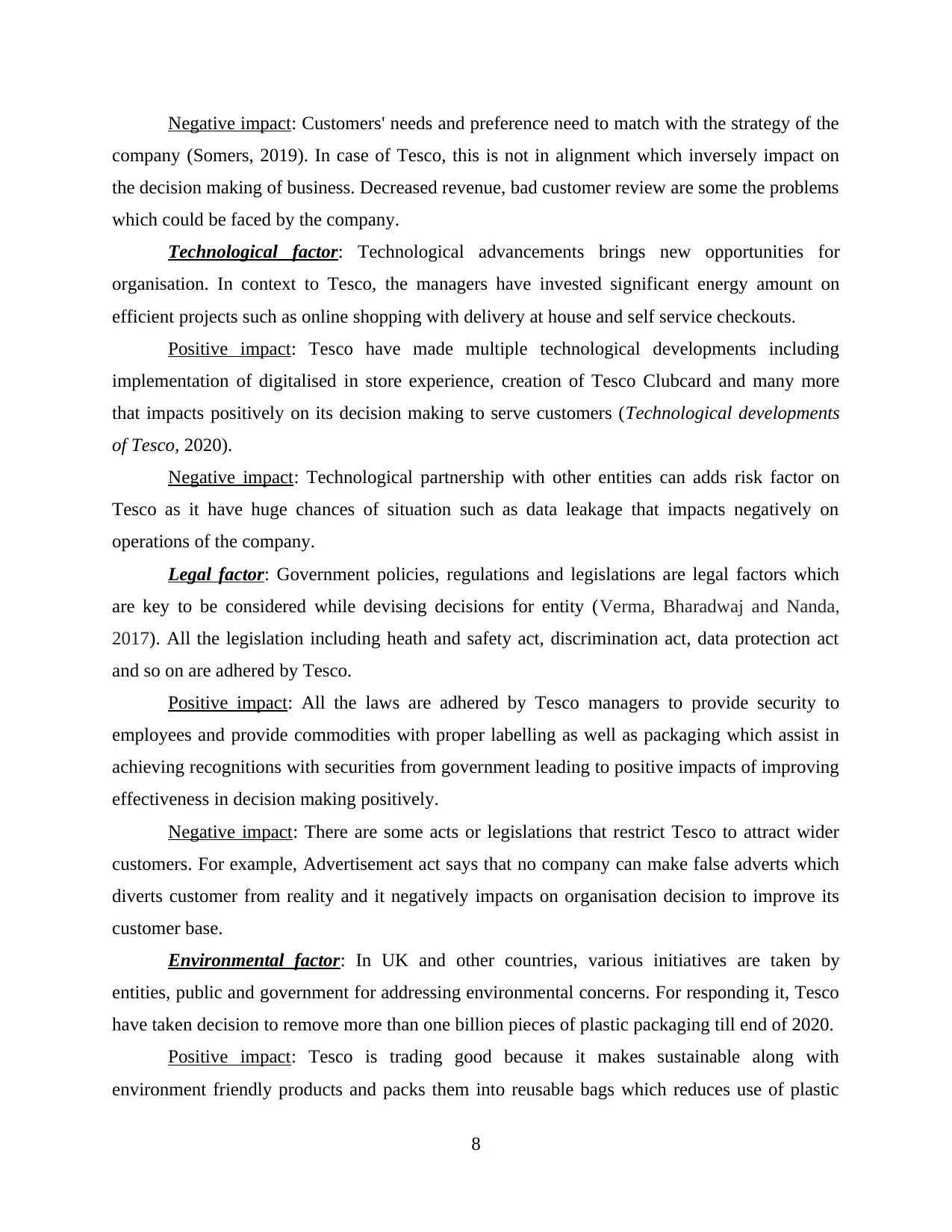
Negative impact: Customers' needs and preference need to match with the strategy of the
company (Somers, 2019). In case of Tesco, this is not in alignment which inversely impact on
the decision making of business. Decreased revenue, bad customer review are some the problems
which could be faced by the company.
Technological factor: Technological advancements brings new opportunities for
organisation. In context to Tesco, the managers have invested significant energy amount on
efficient projects such as online shopping with delivery at house and self service checkouts.
Positive impact: Tesco have made multiple technological developments including
implementation of digitalised in store experience, creation of Tesco Clubcard and many more
that impacts positively on its decision making to serve customers (Technological developments
of Tesco, 2020).
Negative impact: Technological partnership with other entities can adds risk factor on
Tesco as it have huge chances of situation such as data leakage that impacts negatively on
operations of the company.
Legal factor: Government policies, regulations and legislations are legal factors which
are key to be considered while devising decisions for entity (Verma, Bharadwaj and Nanda,
2017). All the legislation including heath and safety act, discrimination act, data protection act
and so on are adhered by Tesco.
Positive impact: All the laws are adhered by Tesco managers to provide security to
employees and provide commodities with proper labelling as well as packaging which assist in
achieving recognitions with securities from government leading to positive impacts of improving
effectiveness in decision making positively.
Negative impact: There are some acts or legislations that restrict Tesco to attract wider
customers. For example, Advertisement act says that no company can make false adverts which
diverts customer from reality and it negatively impacts on organisation decision to improve its
customer base.
Environmental factor: In UK and other countries, various initiatives are taken by
entities, public and government for addressing environmental concerns. For responding it, Tesco
have taken decision to remove more than one billion pieces of plastic packaging till end of 2020.
Positive impact: Tesco is trading good because it makes sustainable along with
environment friendly products and packs them into reusable bags which reduces use of plastic
8
company (Somers, 2019). In case of Tesco, this is not in alignment which inversely impact on
the decision making of business. Decreased revenue, bad customer review are some the problems
which could be faced by the company.
Technological factor: Technological advancements brings new opportunities for
organisation. In context to Tesco, the managers have invested significant energy amount on
efficient projects such as online shopping with delivery at house and self service checkouts.
Positive impact: Tesco have made multiple technological developments including
implementation of digitalised in store experience, creation of Tesco Clubcard and many more
that impacts positively on its decision making to serve customers (Technological developments
of Tesco, 2020).
Negative impact: Technological partnership with other entities can adds risk factor on
Tesco as it have huge chances of situation such as data leakage that impacts negatively on
operations of the company.
Legal factor: Government policies, regulations and legislations are legal factors which
are key to be considered while devising decisions for entity (Verma, Bharadwaj and Nanda,
2017). All the legislation including heath and safety act, discrimination act, data protection act
and so on are adhered by Tesco.
Positive impact: All the laws are adhered by Tesco managers to provide security to
employees and provide commodities with proper labelling as well as packaging which assist in
achieving recognitions with securities from government leading to positive impacts of improving
effectiveness in decision making positively.
Negative impact: There are some acts or legislations that restrict Tesco to attract wider
customers. For example, Advertisement act says that no company can make false adverts which
diverts customer from reality and it negatively impacts on organisation decision to improve its
customer base.
Environmental factor: In UK and other countries, various initiatives are taken by
entities, public and government for addressing environmental concerns. For responding it, Tesco
have taken decision to remove more than one billion pieces of plastic packaging till end of 2020.
Positive impact: Tesco is trading good because it makes sustainable along with
environment friendly products and packs them into reusable bags which reduces use of plastic
8
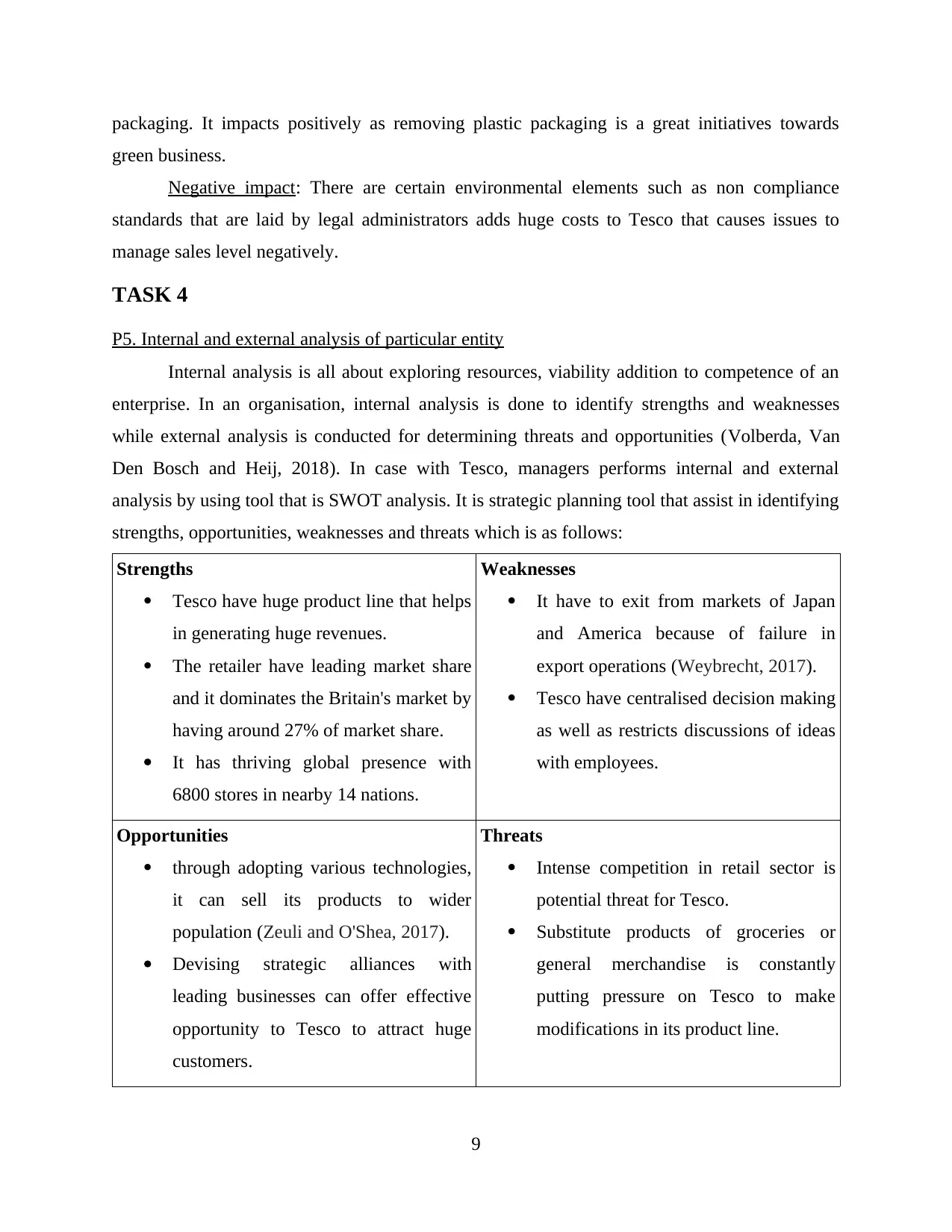
packaging. It impacts positively as removing plastic packaging is a great initiatives towards
green business.
Negative impact: There are certain environmental elements such as non compliance
standards that are laid by legal administrators adds huge costs to Tesco that causes issues to
manage sales level negatively.
TASK 4
P5. Internal and external analysis of particular entity
Internal analysis is all about exploring resources, viability addition to competence of an
enterprise. In an organisation, internal analysis is done to identify strengths and weaknesses
while external analysis is conducted for determining threats and opportunities (Volberda, Van
Den Bosch and Heij, 2018). In case with Tesco, managers performs internal and external
analysis by using tool that is SWOT analysis. It is strategic planning tool that assist in identifying
strengths, opportunities, weaknesses and threats which is as follows:
Strengths
Tesco have huge product line that helps
in generating huge revenues.
The retailer have leading market share
and it dominates the Britain's market by
having around 27% of market share.
It has thriving global presence with
6800 stores in nearby 14 nations.
Weaknesses
It have to exit from markets of Japan
and America because of failure in
export operations (Weybrecht, 2017).
Tesco have centralised decision making
as well as restricts discussions of ideas
with employees.
Opportunities
through adopting various technologies,
it can sell its products to wider
population (Zeuli and O'Shea, 2017).
Devising strategic alliances with
leading businesses can offer effective
opportunity to Tesco to attract huge
customers.
Threats
Intense competition in retail sector is
potential threat for Tesco.
Substitute products of groceries or
general merchandise is constantly
putting pressure on Tesco to make
modifications in its product line.
9
green business.
Negative impact: There are certain environmental elements such as non compliance
standards that are laid by legal administrators adds huge costs to Tesco that causes issues to
manage sales level negatively.
TASK 4
P5. Internal and external analysis of particular entity
Internal analysis is all about exploring resources, viability addition to competence of an
enterprise. In an organisation, internal analysis is done to identify strengths and weaknesses
while external analysis is conducted for determining threats and opportunities (Volberda, Van
Den Bosch and Heij, 2018). In case with Tesco, managers performs internal and external
analysis by using tool that is SWOT analysis. It is strategic planning tool that assist in identifying
strengths, opportunities, weaknesses and threats which is as follows:
Strengths
Tesco have huge product line that helps
in generating huge revenues.
The retailer have leading market share
and it dominates the Britain's market by
having around 27% of market share.
It has thriving global presence with
6800 stores in nearby 14 nations.
Weaknesses
It have to exit from markets of Japan
and America because of failure in
export operations (Weybrecht, 2017).
Tesco have centralised decision making
as well as restricts discussions of ideas
with employees.
Opportunities
through adopting various technologies,
it can sell its products to wider
population (Zeuli and O'Shea, 2017).
Devising strategic alliances with
leading businesses can offer effective
opportunity to Tesco to attract huge
customers.
Threats
Intense competition in retail sector is
potential threat for Tesco.
Substitute products of groceries or
general merchandise is constantly
putting pressure on Tesco to make
modifications in its product line.
9
⊘ This is a preview!⊘
Do you want full access?
Subscribe today to unlock all pages.

Trusted by 1+ million students worldwide
1 out of 14
Related Documents
Your All-in-One AI-Powered Toolkit for Academic Success.
+13062052269
info@desklib.com
Available 24*7 on WhatsApp / Email
![[object Object]](/_next/static/media/star-bottom.7253800d.svg)
Unlock your academic potential
Copyright © 2020–2025 A2Z Services. All Rights Reserved. Developed and managed by ZUCOL.





